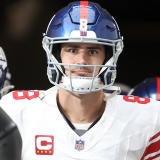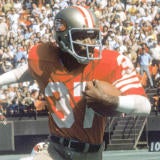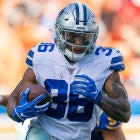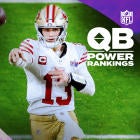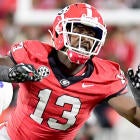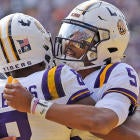Throughout this week, we've been taking a look at how high-level players will affect their new teams. We began by exploring how Odell Beckham's prowess as a deep ball receiver will impact Baker Mayfield, Jarvis Landry, and the rest of the Cleveland Browns offense. Next we examined how Le'Veon Bell's versatility can aid second-year Jets quarterback Sam Darnold in a breakout season. And on Wednesday, we dove into the contrasting skill sets of Antonio Brown and Derek Carr, and how their success as teammates might be dependent on each of them doing things that are not necessarily comfortable for them.
As the season draws nearer, however, I've been thinking about the teams who will or could be working without important pieces of their offense. With that in mind, it's time to analyze how a few players who are in line to replace them, and how their respective skill sets will impact what those offenses look like in the field once the season begins.
Ezekiel Elliott -> Tony Pollard
Cowboys owner Jerry Jones intimated on Wednesday that he and the team are prepared and willing to play without their star running back for at least part of the season so long as he is back in the fold for a potential playoff run, and new offensive coordinator Kellen Moore's usage of the team's rookie fourth-round pick during the preseason indicates that Pollard will be in line for a big role should Elliott decide to sit out real games as he attempts to leverage his way into a new contract. To wit: Dak Prescott has been on the field for 31 snaps during the Cowboys' three preseason games; Pollard has been on the field for all 31 of those snaps, and has touched the ball on 18 of them, gaining 103 total yards.
Pollard was a much different player in college than Elliott has been in the pros, but he has shown both in training camp and during his preseason appearances that he's capable of working as something resembling a full-time back. Pollard's merits as a draft pick for Dallas were mostly based on his proficiency as a receiver during his days at Memphis, where he caught 104 passes for 1,292 yards and nine scores. The Cowboys initially viewed him as an Alvin Kamara-like complement to Elliott, but it's not like they have simply been using Pollard as a space back during the preseason: nine of his 15 carries have come between the tackles, and he's gained 63 yards on those plays, to go along with four first downs and one score.
Though he carried the ball only 139 times in three college seasons, he averaged 7.1 yards per attempt on those totes, and his 5.6 yards per attempt in preseason rank second among 61 qualified backs, per Pro Football Focus. His 3.47 yards after contact per carry, meanwhile, rank fifth among 60 running backs with 15-plus preseason carries. Pollard also ranks fifth in the league in PFF's Elusive Rating, with a 96.3 score that would have ranked second among the 47 backs who carried the ball at least 100 times in 2018.
Pollard seems pretty unlikely to average the 25.1 touches per game Elliott has received during his three-year career, but 12-15 carries and 3-5 receptions per game seem well within the realm of possibility if he enters the season as the team's lead back. Such a touch distribution would mean the Cowboys leaning more into the pass game than they have during Dak Prescott's career, but given the indications that Moore is looking to modernize the offense from what the team was running under deposed coordinator Scott Linehan, that type of shift would make sense anyway.
Lamar Miller -> Duke Johnson
In the same way Pollard is a different player than Elliott, Johnson has been a different player than Lamar Miller and Alfred Blue. The Texans seemed prepared to use Johnson in a similar fashion to how he was used throughout his tenure with the Cleveland Browns, but after Miller's ACL tear, reports indicate that he will be more of a lead back than he has ever been during his time in the NFL.
Johnson has essentially been pigeonholed as a pass-catching back during his four professional seasons, but that's not at all what he was in college. He averaged 15.9 carries per game (and 6.7 yards per carry) during three years at the University of Miami, and left school as the all-time leading rusher in Hurricanes history. Since entering the league, he's receiving only 4.7 carries per game despite the fact that he was more effective than players like Isaiah Crowell, Carlos Hyde, and Robert Turbin, even as a runner.
Perhaps the biggest difference between Johnson and the player(s) he's replacing in Houston, though, is his effectiveness both as a receiver and a playmaker with the ball in his hands in open space.
| Player | Rec | Tgt | Rec % | Yards | YPA | TD | 1D |
|---|---|---|---|---|---|---|---|
| HOU RB | 77 | 101 | 76.2% | 672 | 6.65 | 4 | 28 |
| Duke | 235 | 303 | 77.6% | 2170 | 7.16 | 8 | 73 |
Despite being on the field for only 2,044 of Cleveland's 4,293 offensive snaps (47.6 percent) during his career, Johnson has averaged more catches per game (3.7 to 3.3), receiving yards per game (33.9 to 29.2), and yards per reception (7.16 to 6.65) than all Texans running backs combined during Deshaun Watson's 23 career games played.
To give you an idea of just how under-utilized he's been in his career, Johnson has ranked inside the top 12 in PFF's Elusive Rating every single season he's been in the league. The full list of players who have done that: Duke Johnson. That's it. He's a tackle-breaking machine, forcing at least one defender to miss every 3.93 times he's touched the ball throughout his career. By way of comparison, Miller and Blue forced a miss tackle every 8.27 touches in 2018.
His skills in these areas will be particularly valuable in the context of this Texans offense because: A. Watson has never played with a player like him; B. the Texans' offensive line is terrible and having someone who can act as both a short-area receiver and make defenders miss should aid the offense in turning negative plays into positive ones; and C. he can flex out into the slot to handle some of the role vacated by the oft-injured Keke Coutee, a player for whom they had no real replacement when he was out of the lineup last season.
Rob Gronkowski -> Josh Gordon
This is not as clean a one-for-one replacement as the prior two examples, but Gordon is a similar kind of big-bodied, physical receiver who can make plays both in short yardage and downfield as Gronkowski. He has also proven himself an excellent red-zone weapon when on the field throughout his career, and that's an area where Gronk was particularly effective during his time with the Patriots.
During his short stint in New England last season, Gordon gradually ramped up his snap rate, playing sparingly in the first few weeks before essentially becoming a full-time receiver prior to his most recent suspension and the announcement that he would take time away from the team to focus on his mental health.
And despite being only a part-time player for much of his tenure, Gordon still caught 40 of 68 passes from Tom Brady for 720 yards and three scores. Brady's 116.7 passer rating on throws to Gordon was spectacular, and the 11.3 yards per attempt Brady averaged on those throws is the best mark he has among any of the receivers he has ever thrown to. And as Pro Football Focus noted, he had a particularly strong effect on New England's play-action attack:
The Pats offense used play action 31.7% of the time in 2018, the second-highest rate in the NFL behind only the Los Angeles Rams. With Gordon, the Patriots offense averaged 10.3 yards per play (T-1st) with play action compared to the 7.5 yards per play in games without Gordon in 2018 (17th). Of all New England's wide receivers, Gordon earned the highest receiving grade on play-action plays (83.8) while earning the most receiving yards (354) and second-most explosive plays (11). Gordon also reeled in as many contested catches on play-action passes (3) as the rest of the side's wide receivers combined.
Considering how big a part of the Patriots offense play-action already was, and how that share is likely to grow given the team's seemingly impending reliance on more rushing plays this season, it's always beneficial to have a player who excels at making plays in those situations.
Better yet, it's beneficial to have a guy who can not only make those plays and win on contested catches, but who can also make hay after he gets the ball at the point of the catch. Gordon's 6.7 yards after catch per reception last season ranked fourth out of 96 receivers and tight ends who received at least 50 targets. Given New England's reliance on short passes and getting the ball to players in open space and allowing them to do with it what they will, that makes him an excellent fit. If he can stay on the field, he should help Brady and company alleviate the loss of one of the game's most dangerous targets.







